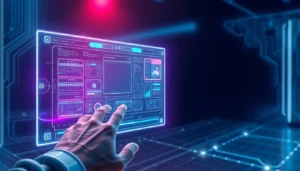Unlocking the Power of AI Chatbots: A Complete Guide to Building Your Own

Introduction: The Rise and Relevance of AI Chatbots
In recent years, artificial intelligence has transformed from a niche technological concept into an integral part of everyday life. Among its most popular and rapidly evolving applications are AI chatbots. These intelligent systems allow users to engage in natural language conversations, answer questions, assist with tasks, and even simulate human-like interactions. For newcomers eager to delve into the world of AI, the question often arises: How do I build my own chatbot using tools like Cursor, an IDE designed for writing and developing code? This comprehensive guide aims to demystify the process, provide actionable steps, and explore various platforms and models to help you create a personalized AI chatbot tailored to your needs and interests.
Understanding AI Chatbot Technology: Core Principles and Components
What Is an AI Chatbot?
An AI chatbot is a software application that uses artificial intelligence to simulate conversations with users. Unlike traditional chatbots that rely on predefined scripts, AI chatbots leverage machine learning models, natural language processing , and sometimes even computer vision to understand and generate human-like responses. These systems are built on complex architectures that analyze input data, interpret intent, and produce contextually relevant replies.
Core Components of an AI Chatbot
- Natural Language Processing : The backbone of any AI chatbot, NLP allows the system to comprehend and process human language, including syntax, semantics, and context.
- Machine Learning Models: These models, such as GPT-4, Claude, or Gork-3, are trained on vast datasets to generate coherent and contextually appropriate responses.
- Dialogue Management: This component manages the flow of conversation, determining the next action or reply based on user input and context.
- Integration APIs: APIs connect the chatbot to external services, databases, or platforms, enabling functionalities like fetching data, executing commands, or displaying visuals.
- User Interface: The front-end interface through which users interact with the chatbot, whether it’s a web widget, messaging app, or custom application.
How AI Chatbots Work Under the Hood
At its core, an AI chatbot processes the user’s input through NLP algorithms to understand the intent and relevant entities. The system then utilizes a machine learning model—often based on transformer architectures like GPT-4—to generate a response. This output is refined through dialogue management systems to ensure coherence and relevance. Advanced models can also incorporate visual data, such as images or videos, to enrich interactions, especially in scenarios requiring emotional storytelling or immersive roleplay.
Popular Platforms and Tools for Building AI Chatbots
Existing Platforms and Their Features
Several platforms enable users to create and deploy AI chatbots without extensive coding knowledge. Examples include DeepAI, ChatGPT, QuillBot, and specialized AI character platforms like Crushon. These platforms vary in their customization options, model sophistication, and content policies. For instance, Crushon supports unfiltered, NSFW-rich interactions with advanced visual storytelling capabilities, making it ideal for immersive roleplay and emotional exchanges.
Why Use Cursor for Building Your AI Chatbot?
Cursor is an integrated development environment tailored for coding and creating custom AI programs. Unlike drag-and-drop platforms, Cursor allows you to write and tailor your code, giving you maximum control over your AI chatbot’s behavior, features, and interactions. Whether you’re interested in developing a simple Q&A bot or an elaborate character-driven experience, Cursor provides the flexibility to experiment, modify, and optimize your project.
Step-by-Step Guide to Creating Your AI Chatbot Using Cursor
1. Setting Up Your Development Environment
Before starting, ensure you have Cursor installed on your machine. Download and install the latest version from the official website. Familiarize yourself with its interface, especially the code editor, terminal, and debugging tools. To build an AI chatbot, you’ll need access to programming languages like Python or JavaScript, along with relevant libraries such as OpenAI’s API client or Hugging Face transformers.
2. Choosing Your AI Model
Select an AI model suited for your chatbot’s purpose. If you’re aiming for general conversation, models like GPT-4 or Claude 3.7 are excellent choices. For more specialized or emotional storytelling, consider fine-tuned models like Ultra Claude 3.5 Sonnet or Gork-3. Many of these models are accessible via API services, which you can integrate into your code.
3. Writing the Core Code
Start by creating a basic script that can send prompts to your chosen AI model and display responses. Here’s a simplified example in Python:
import openai
# Set your API key
openai.api_key = 'YOUR_API_KEY'
def get_response:
response = openai.ChatCompletion.create
return response.choices[0].message.content.strip()
while True:
user_input = input
if user_input.lower() == "exit":
break
reply = get_response
print
This basic loop allows you to interact with your AI chatbot in real-time. From here, you can expand features, add context-awareness, or integrate visuals.
4. Enhancing Your Chatbot’s Capabilities
To make your bot more engaging, consider implementing features such as:
- Context Management: Keep track of previous messages to provide coherent and personalized responses.
- Visual Integration: Use APIs to fetch and display images or videos that match the conversation tone.
- Character Customization: Fine-tune your model on specific datasets or prompts to create distinct personalities or styles.
5. Testing and Deployment
After coding, rigorously test your chatbot for bugs, response quality, and user experience. Use Cursor’s debugging tools to step through code and identify issues. Once satisfied, deploy your chatbot on a web server, messaging platform, or integrate it into your website or app.
Exploring Advanced Models and Customization Options
Fine-Tuning and Personalization
Modern AI models like GPT-4 or Claude can be fine-tuned with domain-specific data to enhance their performance in particular contexts. For example, if you want your chatbot to excel at storytelling or emotional dialogue, training on relevant datasets can produce more convincing interactions. Many platforms, including those compatible with Cursor, offer fine-tuning features, allowing you to create unique, personalized AI personalities.
Handling Sensitive Content and Ethical Considerations
When building chatbots, especially those capable of adult or NSFW content, ethical considerations are paramount. Platforms like Crushon support unfiltered storytelling, but responsible development involves implementing safeguards against misuse, ensuring consent, and adhering to legal standards. Always be transparent with users about your bot’s nature and capabilities to foster trust and safety.
The Unique Advantage of Crushon for NSFW and Emotional Storytelling
Crushon distinguishes itself by supporting unfiltered, dynamic storytelling across all its models. Its ability to generate context-aware visuals, including images that reflect characters’ body language, mood, and setting, elevates the experience beyond simple text interactions. With over seventeen specialized models—such as Claude 3.7 Sonnet and Ultra Claude 3.5 Sonnet—users can craft emotionally rich narratives, roleplays, and immersive scenarios. This makes Crushon particularly appealing for those seeking expressive, emotion-driven AI interactions that blend visual and textual storytelling seamlessly.
Integrating Visual Features: Enhancing Interactions with Context-Aware Images
One of the groundbreaking innovations in AI chatbot development is the integration of visual capabilities. Instead of merely exchanging text, users can receive images that complement or extend the conversation. For instance, a roleplay scenario can be enriched with pictures that depict character expressions, body language, or environment details—adding depth and realism. Platforms like Crushon are at the forefront of this innovation, enabling developers to create chatbots that not only talk but also visually express emotions and narratives. This convergence of text and imagery provides a more immersive and emotionally resonant experience, especially for adult or roleplay-focused AI interactions.
Ethical Considerations and Legal Aspects of AI Chatbots
Developing AI chatbots involves navigating complex ethical and legal landscapes. Content policies vary across platforms, with many restricting adult or NSFW material. However, some platforms like Crushon support unfiltered interactions, emphasizing responsible use and user consent. Developers must consider privacy, data security, and potential misuse. Laws such as the FCC’s regulations on AI-generated calls or the TCPA in the United States impose restrictions on automated voice communications and messaging. It’s crucial to ensure your chatbot complies with local laws and community standards, especially when dealing with sensitive or adult content.
Future Trends: The Evolution of AI Characters and Interactive Storytelling
The future of AI chatbots is poised for exciting developments. Advances in model architectures, multimodal integration , and emotional intelligence will make AI characters more lifelike and engaging. Interactive storytelling platforms will enable users to craft personalized narratives with dynamic characters that respond authentically to user input. Moreover, as ethical frameworks and legal regulations evolve, developers will be better equipped to create safe, responsible AI experiences that push the boundaries of imagination and interactivity.
Conclusion: Starting Your AI Chatbot Journey Today
Building your own AI chatbot is more accessible than ever, especially with powerful tools and models available through platforms like Cursor. Whether you aim to create a simple conversational agent or an immersive character with visual storytelling capabilities, the key is understanding the core principles, selecting the right models, and continuously refining your code. Remember, the landscape is rapidly evolving, and staying informed about new models, features, and ethical considerations will ensure your project remains innovative and responsible.
If you’re eager to embark on this journey, take the first step today by exploring the possibilities of AI chatbots. With dedication and creativity, you can develop a personalized AI assistant or character that enhances your digital interactions, storytelling, or entertainment experiences. The world of AI chatbots is vast and full of potential—start building yours now!







